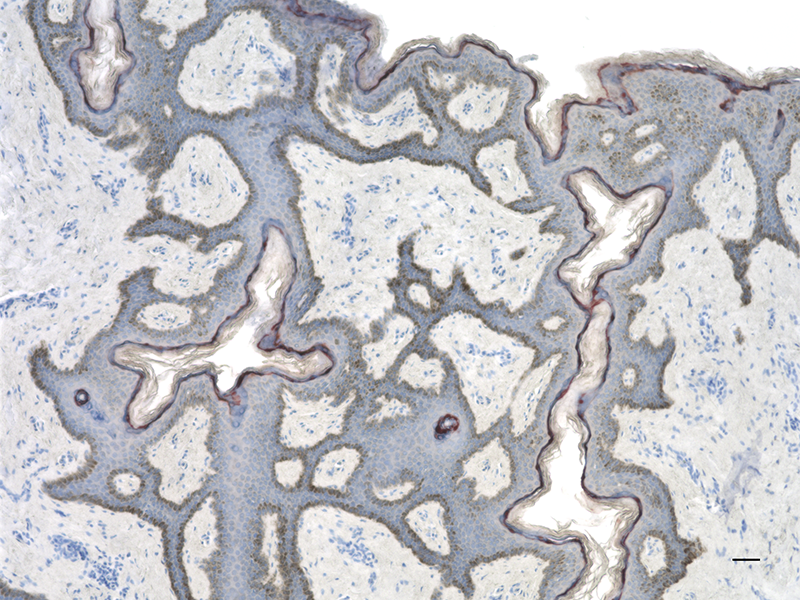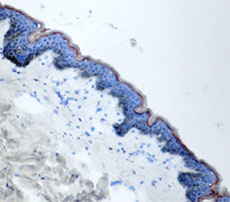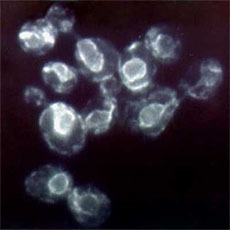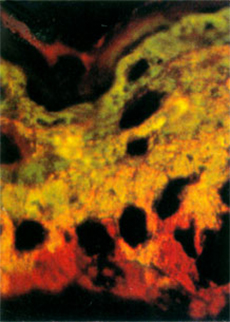- Clone
- Poly19244 (See other available formats)
- Regulatory Status
- RUO
- Other Names
- IVL
- Previously
-
Covance Catalog# PRB-140C
- Isotype
- Rabbit Polyclonal IgG
- Ave. Rating
- Submit a Review
- Product Citations
- publications

-

IHC staining of anti-Involucrin antibody (clone Poly19244) on formalin-fixed paraffin-embedded mouse skin tissue. Following antigen retrieval using Sodium Citrate H.I.E.R., the tissue was incubated with a 1:1000 dilution of the primary antibody for 60 minutes at room temperature. BioLegend´s Ultra-Streptavidin (USA) HRP kit (Multi-Species, DAB, Cat. No. 929901) was used for detection followed by hematoxylin counterstaining, according to the protocol provided. The image was captured with a 40X objective. -

Total lysates (15 µg protein) from HaCaT (Positive control) and THP-1 (Low expression negative control) were resolved by electrophoresis (4-20% Tris-glycine gel), transferred to nitrocellulose, and probed with 1:5000 Involucrin antibody, clone Poly19244. Proteins were visualized using chemiluminescence detection by incubation with HRP Donkey anti-Rabbit secondary antibody (Cat. No. 406401, 1:3000 dilution). Direct-Blot™ HRP anti-β-actin was used as a loading control (Cat. No. 643807, 1:8000 dilution).
| Cat # | Size | Price | Quantity Check Availability | Save | ||
|---|---|---|---|---|---|---|
| 924401 | 200 µL | £257 | ||||
Involucrin serves as a marker for terminal differentiation of stratified squamous epithelia. The involucrin genes have diverged considerably through evolution and as a consequence antibodies specific for the human molecule do not detect the homologous mouse gene product.
Product DetailsProduct Details
- Verified Reactivity
- Mouse
- Antibody Type
- Polyclonal
- Host Species
- Rabbit
- Formulation
- This polyclonal antibody was generated against an 18 amino acid peptide (ELHLGKQQESHEPDMAED) predicted from the mouse involucrin gene sequence.
- Preparation
- Serum
- Storage & Handling
- Store at -20°C. Upon initial thawing, apportion into working aliquots and store at -20°C. Avoid repeated freeze-thaw cycles to prevent denaturing the antibody. For long-term storage, keep the antibody at -80°C.
- Application
-
IHC-P - Quality tested
WB - Verified
IHC-F, ICC - Reported in the literature, not verified in house - Recommended Usage
-
Each lot of this antibody is quality control tested by formalin-fixed paraffin-embedded immunohistochemical staining. For immunohistochemistry, a dilution range of 1:500 - 1:1000 is suggested. For Western blotting, the suggested use of this reagent is 1:1000 - 1:5000 dilution. It is recommended that the reagent be titrated for optimal performance for each application.
-
Application References
(PubMed link indicates BioLegend citation) -
- Wallace L, et al. 2012. J. Cell Sci. 125: 1750. (IHC-F, WB) PubMed
- Jennemann R, et al. 2012. 21: 586. (IHC-P, WB)
- Merritt AJ, et al. 2002. Mol Cell Biol. 22:5846. (IHC-P, WB)
- Lin AW, Lowe SW. 2001. PNAS. 98:5025. (IHC-F, WB, ICC)
- Djian P, et al. 2000. J Cell Biol. 151:F5. (ICC, WB, IHC-P) PubMed
- Li ER, et al. 2000. Exp Dermatol. 9:431. (WB)
- Bayo P, et al. 2008. Endocrinology. 149: 1377. (IHC-P) PubMed
- Product Citations
-
- RRID
-
AB_2565452 (BioLegend Cat. No. 924401)
Antigen Details
- Structure
- Predicted MW = ~68 kD, however bands ~78 kD are detectable depending on nature of source material (refer to Li ER et al paper below).
- Biology Area
- Cell Biology, Cell Motility/Cytoskeleton/Structure, Neuroscience, Neuroscience Cell Markers
- Gene ID
- 16447 View all products for this Gene ID
- UniProt
- View information about Involucrin on UniProt.org
Related Pages & Pathways
Pages
Related FAQs
Other Formats
View All Involucrin Reagents Request Custom Conjugation| Description | Clone | Applications |
|---|---|---|
| Anti-Involucrin | Poly19244 | IHC-P,WB,IHC-F,ICC |
Customers Also Purchased




Compare Data Across All Formats
This data display is provided for general comparisons between formats.
Your actual data may vary due to variations in samples, target cells, instruments and their settings, staining conditions, and other factors.
If you need assistance with selecting the best format contact our expert technical support team.

 Login / Register
Login / Register 














Follow Us